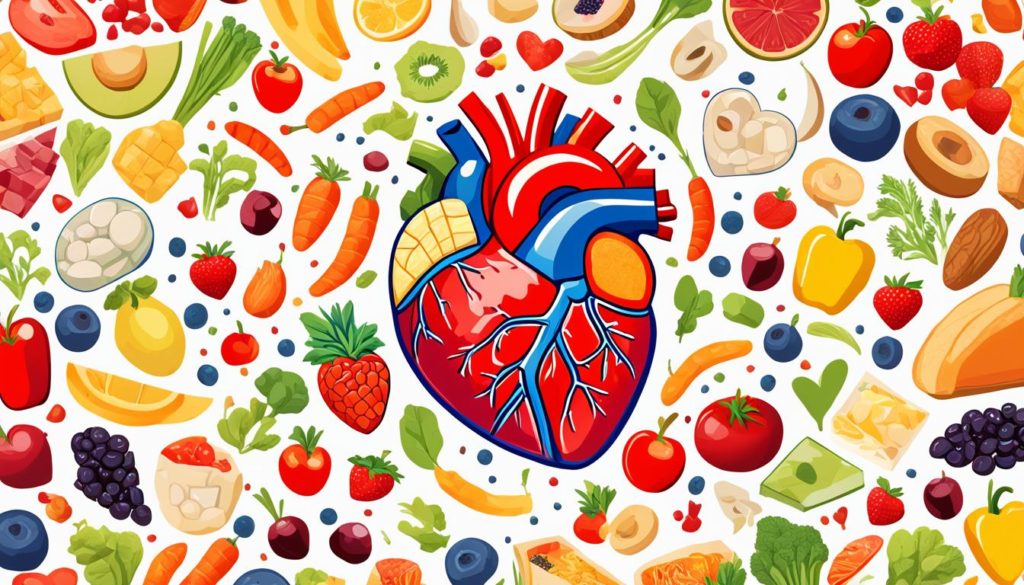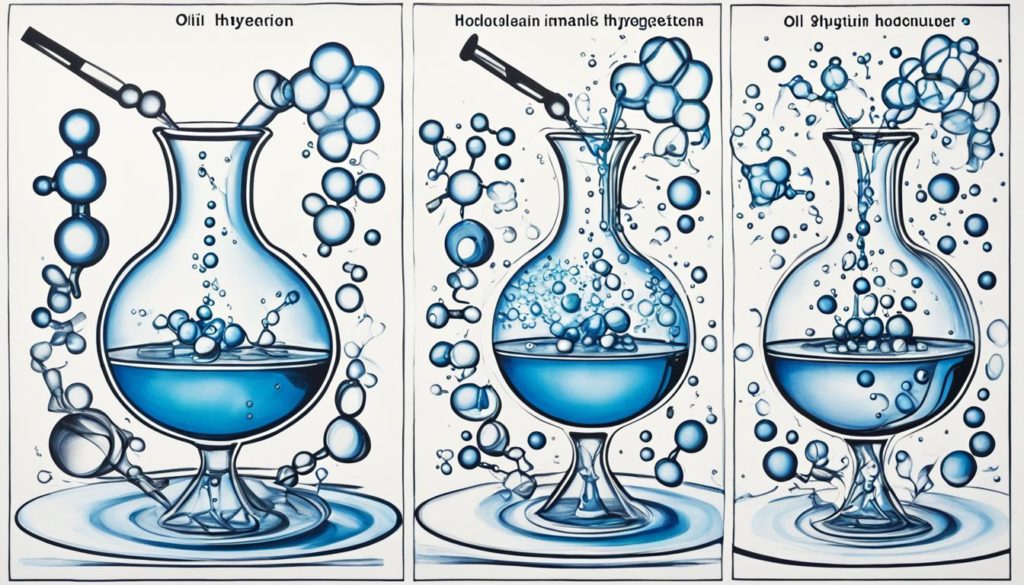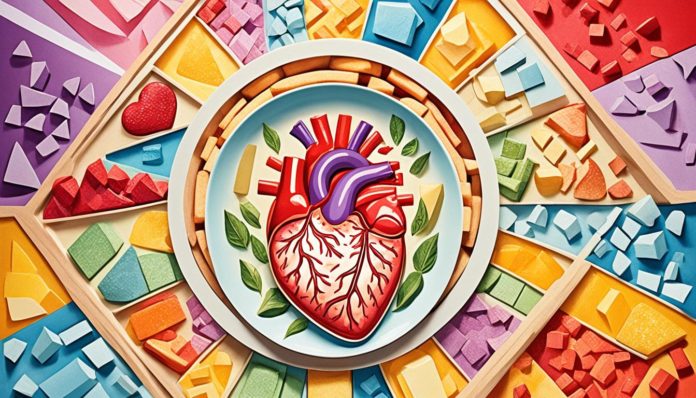Did you know that trans fats cause about 500,000 deaths each year from heart disease worldwide? This fact shows how important it is to know the dangers of trans fats. They are bad for our health, especially our heart health.
Trans fats are a kind of unsaturated fat. They can harm our health if we eat them. Knowing where these fats are found and their risks is key to making better food choices.
Key Takeaways
- Trans fats are linked to around 500,000 annual deaths from coronary heart disease globally.
- Understanding trans fats and their health effects is essential for preventing heart disease.
- Trans fats are often found in processed foods, packaged snacks, and fast food.
- Consuming trans fats can lead to serious long-term health problems.
- Educating yourself on trans fats can help you make healthier dietary choices.
What Are Trans Fats?
Trans fats are a type of unsaturated fat that comes in two forms: natural and artificial. It’s important to know the difference between them to understand their health effects.

Definition of Trans Fats
Trans fats, also known as trans fatty acids, are made when hydrogen is added to vegetable oil. This process makes the oil solid at room temperature. It also makes food last longer and taste better. But there’s more to trans fats than just this process.
Types of Trans Fats: Natural vs. Artificial
There are two main types of trans fats: natural and artificial. Natural trans fats are found in small amounts in animal products like meat and dairy. Artificial trans fats are made in labs. You’ll often find these in processed foods, margarine, and baked goods.
- Natural Trans Fats: These are in the meat and dairy of animals like cows and sheep. They are made in the animals’ stomachs and then go into their muscles and milk.
- Artificial Trans Fats: These are made by adding hydrogen to liquid vegetable oils. This makes them solid. It also makes them last longer and feel less greasy, but they can be bad for your health.
Trans Fats Explained
Trans fats are a big part of the food industry. It’s important to know how they are made and their effects on health. They are created through a complex chemical change that makes food processing and storage easier.
How Trans Fats Are Created
The process starts with the hydrogenation process. This method adds hydrogen to vegetable oils, turning them solid at room temperature. Hydrogen atoms link to the fatty acids in the oils, creating trans fats. This makes oils more stable and longer-lasting.
 are found in many processed foods.
are found in many processed foods.
Common Uses of Trans Fats in Food Industry
Trans fats are used for their texture, flavor, and shelf life in foods. They are in margarine, shortening, and baked goods. These fats keep baked items moist and crumbly.
They are also in fast food and snacks because they are perfect for frying. Despite health worries, they are common because they are cheap and make food taste good.
| Food Product | Reason for Use | Characteristics |
|---|---|---|
| Margarine | Improves spreadability | Semi-solid at room temperature |
| Shortening | Enhances baking quality | Extends shelf life |
| Fried Foods | Optimal frying properties | Crispy texture |
| Commercial Snacks | Flavor enhancement | Improved taste |
Learning about industrial trans fats shows why they are used a lot, even though they are not good for health. It’s important to teach people about the hydrogenation process and trans fat sources. This helps them make better food choices.
Trans Fats and Heart Disease
Studies have shown a strong link between trans fats and heart disease. Eating trans fats can raise bad cholesterol and lower good cholesterol. This can lead to clogged arteries, increasing the risk of heart attacks and strokes.
Trans fats also cause inflammation in the body, which affects artery linings. This can lead to the buildup of plaques that block blood flow. Eating a lot of trans fats can increase the risk of heart disease by 21% and deaths by 28%.
“The American Heart Association recommends limiting trans fat intake to no more than 1% of total daily calories to reduce cardiovascular risks and promote heart health.”
Even small amounts of trans fats can have big health effects. Researchers say cutting out artificial trans fats could prevent thousands of heart problems each year. Foods like baked goods, snack foods, and fried items are often high in trans fats. These foods can increase the risk of heart disease.
| Health Metric | Impact of Trans Fats |
|---|---|
| LDL Cholesterol | Increases |
| HDL Cholesterol | Decreases |
| Inflammation | Increases |
| Arterial Plaque | Increases |
Health Effects of Consuming Trans Fats
Eating trans fats can harm your health in both the short and long term. We’ll look at the immediate effects and the ongoing risks of eating trans fats regularly.
Short-term Effects
Right after eating trans fats, your body can show signs of trouble. These effects include:
- Increased Inflammation: Trans fats can make inflammation worse in your body, causing discomfort and making health problems worse.
- Elevated Cholesterol Levels: Eating trans fats can quickly raise your bad cholesterol and lower your good cholesterol.
- Impaired Endothelial Function: This can hurt the health of your blood vessels, leading to heart problems soon.
Long-term Health Risks
Long-term, eating trans fats can lead to serious health issues. These risks include:
- Heart Disease: Trans fats increase the risk of heart disease by causing plaque to build up in arteries.
- Type 2 Diabetes: Regularly eating trans fats can make you more likely to get insulin resistance, which can lead to diabetes.
- Obesity: Eating trans fats too often can cause weight gain and obesity, leading to more metabolic problems.
- Stroke: Trans fats also raise the risk of stroke by making blood flow worse.
Health groups like the American Heart Association stress the need to cut down on trans fats. This is to avoid these serious health issues.
Common Sources of Trans Fats
Trans fat foods are common in many diets, often hidden in everyday products. It’s important to know where these fats come from to make better choices.
Baked goods are a big source of trans fats. Things like pastries, cakes, cookies, and crackers often have them to last longer and taste better. It’s key to check labels closely.
Fried foods are also a big problem. Fast-food places and restaurants use oils that are cheap and make food taste good. So, foods like French fries, fried chicken, and doughnuts can have a lot of trans fats.
Margarine and shortening are also bad guys. They were once seen as a healthier choice than butter, but many still have a lot of trans fats. Always look for “trans-fat-free” labels, even if it costs more.
Snacks like microwave popcorn, frozen pizzas, and ready meals also have a lot of trans fats. These foods are kept fresh and tasty with trans fats.
“The devil is in the details, particularly when decoding food labels for hidden trans fats. Always scrutinize the ingredient list for terms like ‘partially hydrogenated oils’ and choose products with no trans fats listed,” advises the American Heart Association.
Knowing where trans fat foods come from is key to a heart-healthy diet. Being careful about trans fats can lead to better eating habits for the long run.
Trans Fat Foods to Avoid
To cut trans fats from our diets, we need to know which foods have them. Here, we list common foods to avoid. This will help when shopping or eating out.
Processed Foods and Packaged Snacks
Many processed foods and snacks have unhealthy trans fats. These fats help them last longer and taste better. You can find these items easily in stores. Here are some to avoid:
- Microwave popcorn
- Frozen pizza
- Crackers and chips
- Cakes, cookies, and pastries
- Packaged pudding and frosting
Fast Food and Restaurant Meals
Fast food and restaurant meals are big sources of trans fats. These foods are often fried or cooked with oils high in trans fats. When eating out, choose wisely to cut down on trans fats. Some tips include picking trans fat-free foods and asking about cooking oils. Here are some high-trans-fat items to watch out for:
- French fries
- Fried chicken
- Donuts
- Margarine and spreads
- Baked goods with partially hydrogenated oils
Knowing which foods have trans fats is key to eating better. By making informed choices, we can pick healthier options. This helps us avoid trans fats and supports better heart health.
| Category | Description | Examples |
|---|---|---|
| Processed Foods | Long shelf life, often with added trans fats | Microwave popcorn, frozen pizza, packaged snacks |
| Fast Food | Often fried or cooked with unhealthy oils | French fries, fried chicken, donuts |
| Baked Goods | Often contain partially hydrogenated oils | Cakes, cookies, pastries, packaged pudding |
| Margarine | Used as spreads, may contain trans fats | Margarine, spreads |
Trans Fat Alternatives
Switching to healthier fats can greatly improve your health. Adding healthy fats to your meals cuts down the risks of trans fats. It also boosts your heart health.
Healthier Oil Options
Choosing oils full of monounsaturated and polyunsaturated fats is a smart move. Olive oil and avocado oil are great choices. They taste good and are good for you. Adding sunflower oil or flaxseed oil, which are packed with omega fatty acids, makes your meals even better.
Beneficial Fats for Heart Health
Eating foods rich in omega-3 and omega-6 fatty acids is key for a healthy heart. Fatty fish like salmon and mackerel, nuts, and seeds are great options. These healthy fats keep your heart in good shape and lower inflammation. Eating a diet rich in these fats leads to a balanced and healthy life.
The Importance of Reducing Trans Fats in Your Diet
It’s key to cut down on trans fats to stay healthy and avoid serious illnesses. These fats can up your risk of heart disease, stroke, and diabetes. Knowing why it’s important helps you make better diet choices for your health.
Benefits of Lowering Trans Fat Intake
Lowering trans fat intake greatly reduces heart disease risk. The American Heart Association says eating less trans fat lowers bad cholesterol and raises good cholesterol. It also cuts down on inflammation and boosts heart function.
Tips for Reducing Trans Fats
There are easy ways to cut down on trans fats in your diet. Here are some tips for eating better:
- Always check food labels for partially hydrogenated oils and avoid them.
- Choose lean meats, fresh fruits, veggies, and whole grains over processed foods.
- Use olive oil or avocado oil for cooking and baking instead of others.
- Limit fast foods and restaurant meals that are loaded with trans fats.
- Cook meals at home with fresh ingredients to control the fats you use.
Adding these tips to your daily life helps you focus on reducing trans fats. It’s a step towards a healthier eating lifestyle.
Understanding Trans Fat Labeling
It’s important to know how to read trans fat labels to make better food choices. The nutrition labels guidelines say that trans fats must be listed on packaged foods. But, it can be tricky because there are some loopholes.
Products with less than 0.5 grams of trans fat per serving can say “0 grams” on the label. This might make people think a product has no trans fats. But, eating more than one serving can lead to harmful amounts of trans fats.
When making choices, don’t just look at the trans fat amount. Check the ingredients list too. If you see “partially hydrogenated oils,” the product has trans fats, even if the label says otherwise.
| Key Label Terms | What They Mean |
|---|---|
| 0 grams trans fat | Contains less than 0.5 grams per serving |
| Partially hydrogenated oils | Indicates presence of trans fats |
| Trans fat-free | Legally contains no trans fats |
Knowing about trans fat labeling is key to staying healthy. By looking at both the Nutrition Facts and ingredients, you can follow nutrition labels guidelines and avoid hidden trans fats.
Trans Fat Regulations in the United States
Trans fats are bad for the heart and have been under more scrutiny lately. It’s important for both consumers and manufacturers to understand the history and current state of trans fat rules.
Historical Overview
In the early 1990s, health experts started worrying about trans fats. They found links to higher cholesterol and a greater risk of heart disease. A big step came in 2006 when the FDA made nutrition labels include trans fat information. This was to help people make healthier food choices.
Current Policies and Future Directions
A major change happened in 2015 with the FDA trans fat ban. Starting in 2018, the FDA said partially hydrogenated oils, the main source of artificial trans fats, were no longer safe for human consumption. This move greatly lowered trans fats in American food.
The FDA is still watching food safety to keep people healthy. They plan to make trans fat rules even stricter. This includes watching imported foods and starting public health campaigns. The goal is to get rid of trans fats completely, making sure all food is safer.
| Year | Action | Implications |
|---|---|---|
| 2006 | Nutrition Labeling | Trans fats required to be listed on labels |
| 2015 | FDA Trans Fat Ban | PHOs declared not GRAS |
| 2018 | Ban Effective | Significant reduction in trans fats |
| Future | Enhanced Regulations | Stricter oversight and public health initiatives |
Conclusion
Learning about trans fats and their effects on health is key to making smart food choices. We’ve looked at natural and artificial trans fats and where they come from. This knowledge helps us make better choices for our health.
Natural trans fats can be part of a healthy diet in small amounts. But artificial trans fats are a different story. They can lead to heart disease, inflammation, diabetes, and even cancer risks. For more details, check out this Healthline article.
Thanks to new rules and more awareness, people are eating fewer trans fats. But they’re still in many processed foods, even after the U.S. ban in 2020. It’s important to keep an eye on food labels and choose healthier options. Eating foods with good fats and avoiding processed and fast foods helps your heart stay healthy.
In conclusion, our exploration of trans fats shows how crucial it is to make smart food choices. It’s not just about cutting down on trans fats. It’s about improving our overall health. By paying attention to what we eat and making better choices, we can improve our health and live longer. Let’s work together to avoid harmful trans fats and eat more nutritious foods.
FAQ
What are the health effects of consuming trans fats?
Eating trans fats can lead to serious health issues. These include a higher risk of heart disease, insulin resistance, and inflammation. It can also cause metabolic syndrome. Over time, it may lead to type 2 diabetes, obesity, and some cancers.
Why are trans fats bad for your health?
Trans fats are bad because they increase your bad cholesterol and lower your good cholesterol. This combo greatly raises the risk of heart disease and stroke. So, trans fats are bad for your heart health.
How are trans fats created?
Trans fats are made through a process called hydrogenation. This involves adding hydrogen to liquid vegetable oils to make them solid. This makes foods last longer and taste better but adds unhealthy trans fats.
What are the common sources of trans fats?
Trans fats are found in many processed foods, margarines, baked goods, and snacks like chips and crackers. They are also in fried fast foods and some restaurant meals. These foods often have partially hydrogenated oils, which are high in trans fats.
How can I identify trans fats on food labels?
To spot trans fats on labels, look for “partially hydrogenated oils” in the ingredients list. Even if a label says ‘0 grams of trans fat per serving,’ be careful. Products with less than 0.5 grams per serving can still be labeled this way.
What are some alternatives to trans fats?
Instead of trans fats, use oils like olive oil, canola oil, and avocado oil. Adding fats like omega-3 and omega-6 from fatty fish, nuts, and seeds can also help your heart.
What are the benefits of reducing trans fat intake?
Cutting down on trans fats can make your heart healthier. It lowers bad cholesterol and reduces inflammation. This can lower your risk of chronic diseases like heart disease, diabetes, and obesity.
What tips can help me reduce trans fats in my diet?
To cut down on trans fats, eat whole foods and read labels well. Avoid products with partially hydrogenated oils. Choose baking or grilling over frying. Use liquid oils for cooking instead of solid fats.
How have U.S. regulations changed regarding trans fats?
U.S. rules on trans fats have gotten stricter. The FDA banned partially hydrogenated oils in foods. This rule helps reduce health risks from trans fats and aims to improve public health.


